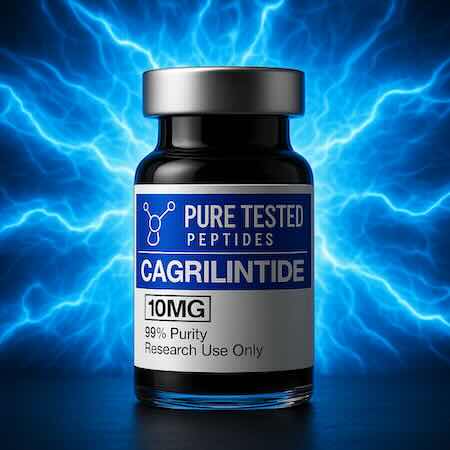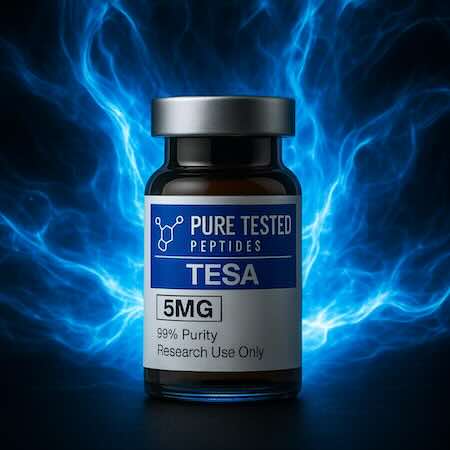Cagrilintide 5mg Peptide Vial Research Notes
Cagrilintide 5mg peptide vial from Pure Tested Peptides is prepared for laboratories that want dependable materials for carefully controlled studies. This page focuses on how research teams can plan, organize, and document projects that make structured use of this peptide while maintaining strict quality and compliance standards. The information here is written in a straightforward, practical tone so that busy lab staff can quickly scan for the details that matter.
Introduction to Cagrilintide 5mg peptide vial
When a lab adds a new peptide to its inventory it is usually looking for three things: clear specifications, consistent purity, and reliable presentation. Cagrilintide 5mg peptide vial is supplied in a clearly labeled vial that indicates the amount, purity, and research-only designation on the front panel. Many research groups appreciate being able to open a storage box, read the label at a glance, and immediately confirm that they are working with the correct vial before preparing a solution or setting up an experiment.
The composition and format of Cagrilintide 5mg peptide vial make it suitable for a wide variety of in-vitro and laboratory-only protocols. Each vial is produced with careful attention to lot tracking so that researchers can associate their observations with the exact batch they used. That traceability becomes invaluable later when teams compare data sets, rerun a protocol, or design follow-up assays that build on earlier work.
Because this product is designated strictly for research, Pure Tested Peptides clearly states that it is not intended for human, animal, or diagnostic use. Labs that order the peptide are expected to have appropriate facilities, standard operating procedures, and safety training in place so that they can handle and store the material responsibly.
The image above illustrates the vibrant visual style Pure Tested Peptides uses for many of its catalog photos. High-resolution images help research teams verify that the vial they receive matches what they expected to order. Some laboratories even print a small copy of the product photo for inclusion in project binders or digital notebooks, making visual identification part of their documentation process.
Specifications, Handling, and Storage
Before incorporating Cagrilintide 5mg peptide vial into a new study, teams typically review specifications such as the amount per vial, nominal purity percentage, and any notes on recommended storage conditions. These details are important because they determine how stock solutions are prepared, how frequently they should be remade, and what type of containers are appropriate for short-term and long-term storage.
Many laboratories prefer to log each vial into an inventory system as soon as it arrives. A typical workflow might include assigning an internal inventory number, scanning the barcode on the shipping label, and recording the lot number from the vial label. Doing this at the receiving bench ensures that no vial is ever used without a clear record of its origin. It also makes it easier to rotate stock so that older vials are used first while newer vials remain in deep storage.
Storage practices vary between institutions, but most research teams using Cagrilintide 5mg peptide vial rely on designated refrigerators or freezers that are reserved for high-value reagents. Temperature logs, access control, and regular maintenance of refrigeration equipment are simple steps that help protect peptide integrity. Clear “research use only” notation further reinforces that the materials are not intended for any type of administration or diagnostic procedure.

Supplemental images showcasing multiple vials together are often used in presentations, internal training documents, or online resource pages. They visually communicate the scale of a peptide program and remind teams that a coordinated approach to storage and documentation is essential when many different products are being evaluated at once.
Designing Laboratory Protocols Involving Cagrilintide 5mg peptide vial
Experimental planning with Cagrilintide 5mg peptide vial usually starts with a written protocol that explains how stock solutions will be prepared, which buffers or solvents will be used, and how aliquots will be labeled. Clear documentation prevents confusion when multiple technicians share responsibilities across different shifts. It also reduces the risk of accidentally reusing containers or misinterpreting concentration labels during a busy day in the lab.
Some groups create dedicated protocol templates just for peptide work. These templates might include fields for entering vial lot numbers, solution preparation dates, storage locations, and disposal procedures. By filling out the same template every time, teams build a consistent archive of information that can be revisited later when they review data or troubleshoot unexpected outcomes.
Because this product is reserved strictly for research, all procedures are confined to appropriate in-vitro systems, cell culture work, or other non-clinical models that align with institutional guidelines. No procedures should be designed around administration to humans or animals, and no claims are made regarding effects outside the context of controlled bench experiments.
Integrating the Peptide into Ongoing Projects
Many laboratories maintain long-running projects in which a new peptide such as Cagrilintide 5mg peptide vial is introduced alongside established controls. In these situations it is important to document exactly when the peptide was first added, which experimental series included it, and how it was handled relative to other reagents. Even small differences in handling can become meaningful when teams compare results across large data sets.
Project managers often schedule regular check-ins to review how reagents are being used. During these meetings they may verify that log books are current, that storage locations are correctly labeled, and that all team members understand the research-only status of the peptide. These check-ins give newer technicians a chance to ask questions and help senior staff spot small procedural gaps before they grow into problems.
Ordering Cagrilintide 5mg peptide vial from Pure Tested Peptides
When a research group finds a supplier that provides clear labeling, consistent packaging, and responsive customer support, it tends to stay with that supplier. Many teams choose Pure Tested Peptides for exactly that reason. The ordering process for Cagrilintide 5mg peptide vial is straightforward: researchers select the item on the website, review the specifications, and complete the checkout using the institution’s preferred payment method or purchase order system.
Because images and descriptions on the site emphasize the research-only nature of each product, it is easy for compliance offices and purchasing departments to confirm that orders align with institutional policies. After the order is placed, tracking information and order confirmations are typically forwarded to both the receiving department and the lead investigator so that everyone knows when to expect delivery.
Upon arrival, vials are inspected to confirm that labeling matches the online description and packing slip. Any discrepancies can be addressed quickly by contacting support, but in practice most orders arrive exactly as expected thanks to standardized packing and labeling procedures.
Record Keeping, Compliance, and Safety
Responsible use of Cagrilintide 5mg peptide vial includes robust record keeping. Many institutions require that each vial be logged in a central system along with its arrival date, lot number, and storage location. Some laboratories also maintain digital copies of certificates of analysis or product specification sheets so that these documents are always available during audits or internal reviews.
Safety training is another key element. Team members who handle peptides should understand how to open vials safely, how to avoid contamination, and how to dispose of unused materials following local regulations. Standard personal protective equipment, such as gloves and lab coats, is normally used whenever reagents are prepared or transferred. These practices are not unique to Cagrilintide 5mg peptide vial; they represent sound laboratory technique that supports reproducible research.
Summary and Research-Only Statement
In summary, Cagrilintide 5mg peptide vial is a clearly labeled research product supplied by Pure Tested Peptides for use in controlled laboratory environments. The vivid product imagery, structured documentation, and consistent packaging all support research teams that value organization and traceability. By pairing good inventory practices with well-written protocols, laboratories can integrate this peptide into experimental designs with confidence in the underlying material.
All products described on this page, including Cagrilintide 5mg peptide vial, are sold strictly for research purposes only. They are not intended for use in humans or animals, are not evaluated for any therapeutic or diagnostic application, and no claims are made or implied regarding their effectiveness in any clinical context. Each laboratory is responsible for ensuring that all local regulations, institutional policies, and safety guidelines are followed when handling these materials.
Research Use Only – no claims are made regarding any use or effectiveness in humans.



